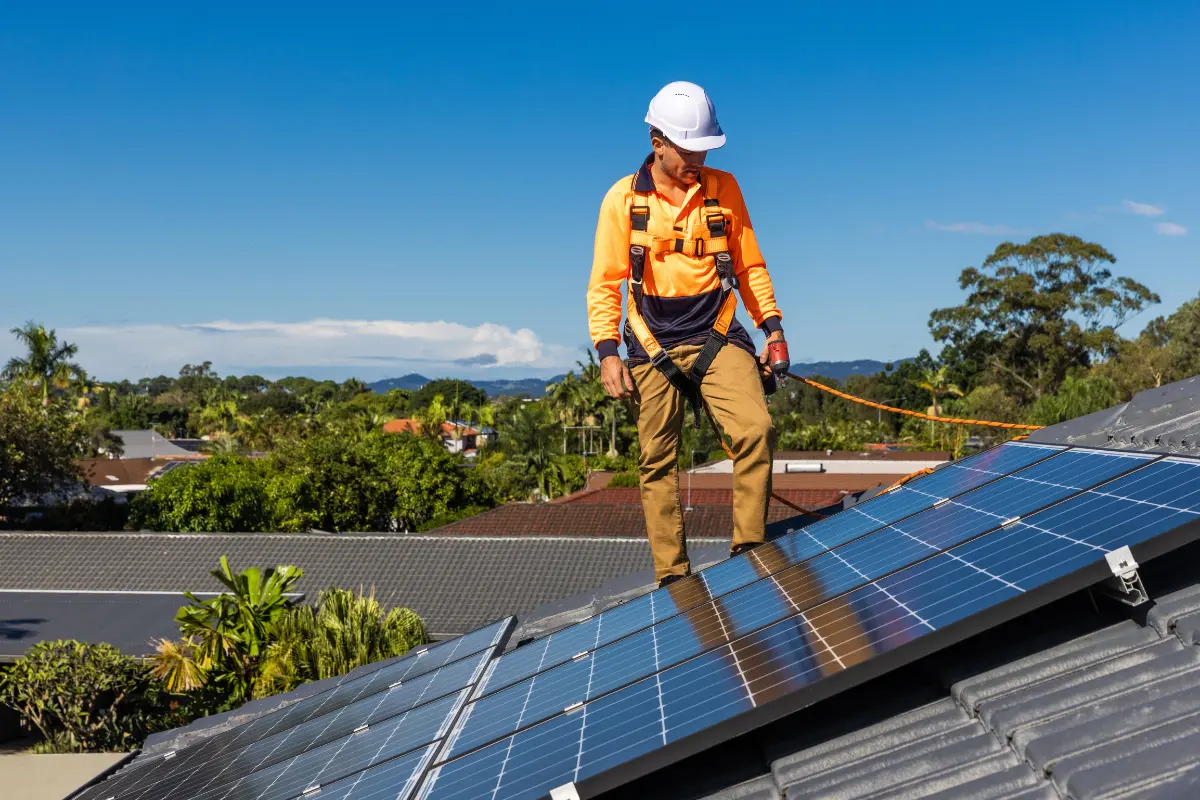5 Reasons to Invest In Solar Panels in Sydney: Embracing Renewable Energy for a Brighter Future
I. Introduction:
A. Brief overview of the growing interest in renewable energy:
Renewable energy is experiencing a surge in global interest as societies seek sustainable alternatives to fossil fuels. With concerns over climate change and environmental degradation, governments, businesses, and individuals are increasingly turning to renewable sources like solar, wind, and hydroelectric power. This growing interest reflects a collective recognition of the urgent need to transition towards cleaner, more sustainable energy solutions to mitigate the impacts of climate change and reduce dependence on finite resources.
B. Introduction to the topic of solar panels in Sydney:
Sydney, renowned for its stunning beaches and vibrant culture, is also embracing the renewable energy revolution, particularly through the widespread adoption of solar panels. As Australia’s largest city, Sydney boasts ample sunlight throughout the year, making it an ideal location for solar energy generation. Homeowners, businesses, and communities across Sydney are increasingly recognizing the benefits of harnessing solar power to reduce energy costs, lower carbon emissions, and contribute to a more sustainable future for the city and its inhabitants.
C. Thesis statement:
Highlighting the five compelling reasons to invest in solar panels in Sydney: In Sydney, investing in solar panels offers an array of compelling benefits that go beyond just financial savings. From reducing energy costs and tapping into abundant sunlight to mitigating environmental impact and leveraging government incentives, there are five key reasons why embracing solar energy is a wise choice for residents and businesses alike. Through this exploration, we’ll uncover how solar panels can empower Sydney siders to take charge of their energy future while contributing to a cleaner, greener, and more resilient community.
II. Rising Energy Costs
A. Current energy pricing trends in Sydney:
Energy pricing in Sydney has been on a steady rise in recent years, reflecting broader trends of increasing electricity costs across Australia. Factors such as infrastructure maintenance, network upgrades, and wholesale electricity prices contribute to this trend. Additionally, regulatory changes and the transition towards renewable energy sources also impact pricing dynamics. As a result, consumers face mounting pressure on their budgets due to higher energy bills, prompting many to seek alternative solutions to manage their electricity expenses.
B. Discussion on the factors contributing to rising electricity costs:
Several factors drive the upward trajectory of electricity costs in Sydney. Aging infrastructure requiring maintenance and upgrades incurs significant expenses passed onto consumers. Additionally, the transition towards cleaner energy sources, while essential for sustainability, often involves initial investment costs that influence pricing. Fluctuating wholesale electricity prices, influenced by market dynamics and supply-demand factors, also contribute to the overall increase in energy costs. Regulatory frameworks, including network tariffs and government levies, further impact pricing structures, compounding the financial burden on consumers and businesses alike.
C. How solar panels offer a solution to mitigate increasing energy expenses:
Solar panels present a viable solution to counter the rising energy expenses in Sydney. By harnessing sunlight to generate electricity, solar panel systems Sydney offer a renewable and sustainable alternative to traditional grid power. Once installed, solar panels Sydney provide a consistent source of energy, reducing reliance on expensive grid electricity. Additionally, solar energy production is independent of fluctuating market prices, offering greater stability in energy costs over the long term. Through net metering and feed-in tariffs, excess solar energy can even be sold back to the grid, providing additional savings and potential income for solar panel owners. Overall, investing in solar panels enables Sydney residents and businesses to take control of their energy expenses while contributing to a greener future.

III. Abundant Sunlight in Sydney
A. Description of Sydney’s climate and sunlight availability:
Sydney enjoys a temperate climate characterized by mild winters and warm summers, with an abundance of sunshine throughout the year. The city experiences an average of over 340 days of sunshine annually, making it an ideal location for solar energy production. With its coastal location and relatively low levels of air pollution, Sydney’s skies often remain clear, allowing for optimal solar radiation penetration. These favourable weather conditions create an environment conducive to efficient solar panel performance and maximize the potential for solar energy generation in the region.
B. Comparison with other regions and cities regarding solar energy potential:
When compared to other regions and cities, Sydney stands out as a prime location for solar energy potential. Its geographic position in the southern hemisphere provides access to ample sunlight year-round, rivalling solar-rich areas around the world. In contrast to cities with more variable weather patterns or higher levels of atmospheric pollution, Sydney’s consistent sunshine and relatively clean air offer advantages for solar energy production. While solar energy potential varies depending on factors such as latitude and climate, Sydney’s favourable conditions position it as a leading candidate for maximizing solar power generation.
C. Benefits of harnessing abundant sunlight for solar energy production:
Harnessing Sydney’s abundant sunlight for solar energy production offers a multitude of benefits for residents, businesses, and the environment. Firstly, solar power reduces reliance on non-renewable energy sources, decreasing greenhouse gas emissions and mitigating climate change. Additionally, solar energy production contributes to energy independence and security, reducing dependence on imported fossil fuels and volatile global energy markets. Economically, investing in solar panels can lead to long-term cost savings by lowering electricity bills and providing a hedge against rising energy costs. Furthermore, solar energy promotes job creation and stimulates local economies through the growth of the renewable energy sector. Overall, harnessing Sydney’s sunlight for solar energy production represents a sustainable and economically viable solution for meeting energy needs while reducing environmental impact.
IV. Environmental Benefits
A. Overview of environmental challenges posed by traditional energy sources:
Traditional energy sources like coal, oil, and natural gas contribute significantly to air and water pollution, greenhouse gas emissions, and habitat destruction. These sources are finite and unsustainable, leading to environmental degradation, climate change, and health risks for ecosystems and human populations.
B. Discussion on the eco-friendly aspects of solar energy:
Solar energy is a clean, renewable resource that produces electricity without emitting greenhouse gases or harmful pollutants. Solar panels generate power using sunlight, a virtually limitless energy source, without depleting natural resources or causing environmental harm. Harnessing solar energy helps mitigate climate change and promotes sustainable development.
C. Reduction of carbon footprint and contribution to a cleaner environment through solar panel investment:
Investing in solar panels enables individuals and businesses to reduce their carbon footprint by displacing electricity generated from fossil fuels. Solar energy production emits no greenhouse gases or pollutants, contributing to cleaner air and water and combating climate change. Solar panel investment fosters a sustainable, eco-friendly energy transition.

V. Government Incentives and Rebates
A. Explanation of government initiatives supporting solar energy adoption:
Governments worldwide are implementing initiatives to encourage the adoption of solar energy. These include subsidies, grants, and financial incentives aimed at reducing the upfront costs of solar panel installation, promoting renewable energy research and development, and creating supportive regulatory frameworks to facilitate solar deployment.
B. Overview of available rebates, tax incentives, and feed-in tariffs in Sydney:
In Sydney, various government incentives are available to promote solar energy adoption. These include rebates, such as the Small-scale Renewable Energy Scheme (SRES), which provides financial assistance for the purchase of solar panels. Additionally, tax incentives, such as rebates or deductions on income tax, and feed-in tariffs, which allow solar panel owners to sell excess electricity back to the grid at a premium rate, further incentivize solar investment.
C. How these incentives make solar panel installation more affordable and economically viable:
Government incentives significantly reduce the upfront costs of solar panel installation Sydney, making it more affordable for homeowners and businesses in Sydney. Rebates and tax incentives directly lower the initial investment, while feed-in tariffs provide ongoing financial benefits through revenue generated from excess energy production. These incentives improve the return on investment for solar panel installation, making it economically viable in the long term.
Energy Independence and Resilience
A. Importance of energy independence in uncertain times:
In uncertain times, such as natural disasters or geopolitical instability, energy independence becomes crucial for ensuring reliable access to power. Relying on centralized energy grids leaves communities vulnerable to disruptions, highlighting the need for decentralized renewable energy sources like solar power to provide resilience and stability.
B. Discussion on how solar panels contribute to energy resilience:
Solar panels enhance energy resilience by decentralizing power generation, reducing dependence on centralized grids vulnerable to outages. During emergencies or grid failures, solar energy systems continue to operate independently, providing a reliable source of electricity for homes, businesses, and critical infrastructure. This resilience ensures uninterrupted power supply, even in challenging circumstances.
C. Case studies or examples showcasing the benefits of solar energy during power outages or emergencies:
Numerous case studies demonstrate the benefits of solar energy during power outages or emergencies. For instance, in Puerto Rico after Hurricane Maria, solar-powered homes and facilities maintained electricity when the grid was down, providing essential services and aiding in recovery efforts. Similarly, during wildfires in California, solar panels enabled residents to maintain power despite grid disruptions, enhancing resilience and safety during emergencies.

Conclusion
A. Recap of the five reasons to invest in solar panels in Sydney:
Investing in solar panels in Sydney offers numerous benefits:
1. Cost Savings: Reduce energy expenses amidst rising electricity costs.
2. Abundant Sunlight: Capitalize on Sydney’s sunny climate for efficient energy generation.
3. Environmental Benefits: Lower carbon footprint and contribute to a cleaner, greener future.
4. Government Incentives: Take advantage of rebates, tax incentives, and feed-in tariffs to make solar investment more affordable.
5. Energy Independence: Enhance resilience by reducing dependence on centralized grids, especially during emergencies.
B. Call to action for readers to consider embracing solar energy for a sustainable future:
Join the movement towards sustainability by embracing solar energy. By investing in solar panels, you not only save money but also contribute to environmental preservation and energy independence. Take action today to reduce your carbon footprint and create a brighter, more sustainable future for generations to come.
C. Final thoughts on the transformative potential of solar energy in Sydney and beyond:
Solar energy holds immense transformative potential, not only for Sydney but for the world at large. As we transition towards renewable energy sources, solar power plays a pivotal role in reshaping our energy landscape, driving economic growth, and mitigating climate change. By harnessing the power of the sun, we can create a more resilient, sustainable, and equitable future for all. Let’s seize this opportunity to build a brighter tomorrow, powered by solar energy.

